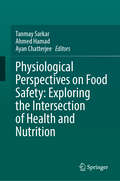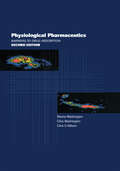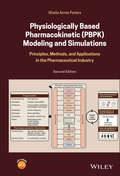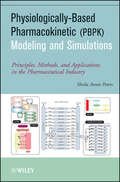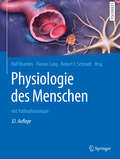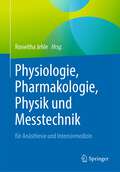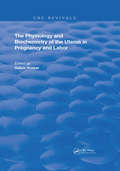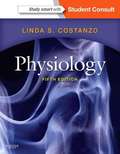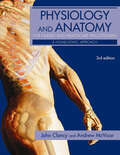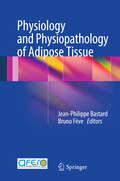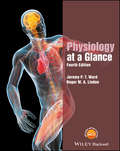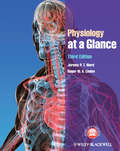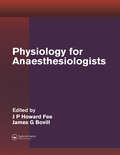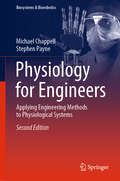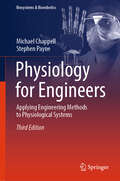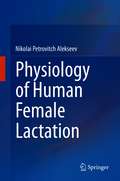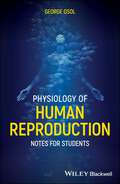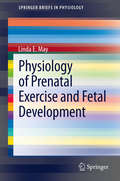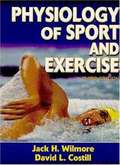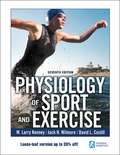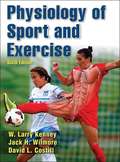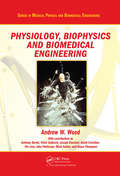- Table View
- List View
Physiological Perspectives on Food Safety: Exploring the Intersection of Health and Nutrition
by Ayan Chatterjee Tanmay Sarkar Ahmed HamadAs food safety concerns become increasingly prevalent, understanding the physiological implications of foodborne pathogens, contaminants, and additives is essential for safeguarding public health. Physiological Perspectives on Food Safety: Exploring the Intersection of Health and Nutrition is a groundbreaking exploration that illuminates the dynamic relationship between food safety and human physiology. This work delves deep into the physiological mechanisms underlying the safety of the foods we consume, offering invaluable insights into how our bodies interact with and respond to the foods we eat. Bridging the gap between the fields of food science and human physiology, Physiological Perspectives on Food Safety: Exploring the Intersection of Health and Nutrition synthesizes cutting-edge research to provide a holistic understanding of the complex interactions between food safety and human health. By exploring topics such as digestive physiology, immune function, metabolic health, and neurological effects, this work sheds light on how food safety practices can impact physiological processes at every stage of life. Through its rigorous analysis, practical insights, and forward-thinking approach, Physiological Perspectives on Food Safety promises to be an indispensable resource for anyone seeking to deepen their understanding of the physiological underpinnings of food safety and its implications for human health and nutrition. It will serve as a vital resource for researchers, healthcare professionals, policymakers, and beyond.
Physiological Pharmaceutics: Barriers to Drug Absorption
by Clive Wilson Neena Washington Clive WashingtonIn recent years, the emphasis in drug development has been the design of new delivery systems rather than new drugs. It is the aim of innovative pharmaceutical scientists to design the new dosage forms to overcome the body's barrier mechanisms which have specifically evolved to exclude foreign material.This book provides an integrated appro
Physiologically Based Pharmacokinetic (PBPK) Modeling and Simulations: Principles, Methods, and Applications in the Pharmaceutical Industry
by Sheila Annie PetersPhysiologically Based Pharmacokinetic (PBPK) Modeling and Simulations The first book dedicated to the emerging field of physiologically based pharmacokinetic modeling (PBPK) Now in its second edition, Physiologically Based Pharmacokinetic (PBPK) Modelling and Simulations: Principles, Methods, and Applications in the Pharma Industry remains the premier reference book throughout the rapidly growing PBPK user community. Using clear and concise language, author Sheila Annie Peters connects theory with practice as she explores the vast potential of PBPK modeling for improving drug discovery and development. This fully updated new edition covers key developments in the field of PBPK modelling and simulations that have emerged in recent years. A brand-new section provides case studies in different application areas of PBPK modelling, including drug-drug interaction, genetic polymorphism, renal impairment, and pediatric extrapolation. Additional chapters address topics such as model-informed drug development (MIDD) and expose readers to a wide range of current applications in the field. Throughout the book, substantially revised chapters simplify complex topics and offer a balanced view of both the opportunities and challenges of PBPK modelling. Providing timely and comprehensive coverage of one of the most exciting new areas of pharmaceutical science, this book: Describes the principles behind physiological modeling of pharmacokinetic processes, inter-individual variability, and drug interactions for small molecule drugs and biologics Features a wealth of new figures and case studies of the applications of PBPK modelling along the value chain in drug discovery and development Reflects the latest regulatory guidelines on the reporting of PBPK modelling analysis Includes access to a new companion website containing code, datasets, explanations of case examples in the text, and discussion of key developments in the field Contains a brief overview of the field, end-of-chapter keywords for easy reference, and an extensive bibliography Physiologically Based Pharmacokinetic (PBPK) Modeling and Simulations: Principles, Methods, and Applications in the Pharmaceutical Industry, Second Edition is an indispensable single-volume resource for beginning and intermediate practitioners across the pharmaceutical sciences in both industry and academia.
Physiologically-Based Pharmacokinetic (PBPK) Modeling and Simulations
by Sheila Annie PetersThe only book dedicated to physiologically-based pharmacokinetic modeling in pharmaceutical sciencePhysiologically-based pharmacokinetic (PBPK) modeling has become increasingly widespread within the pharmaceutical industry over the last decade, but without one dedicated book that provides the information researchers need to learn these new techniques, its applications are severely limited. Describing the principles, methods, and applications of PBPK modeling as used in pharmaceutics, Physiologically-Based Pharmacokinetic (PBPK) Modeling and Simulations fills this void. Connecting theory with practice, the book explores the incredible potential of PBPK modeling for improving drug discovery and development. Comprised of two parts, the book first provides a detailed and systematic treatment of the principles behind physiological modeling of pharmacokinetic processes, inter-individual variability, and drug interactions for small molecule drugs and biologics. The second part looks in greater detail at the powerful applications of PBPK to drug research. Designed for a wide audience encompassing readers looking for a brief overview of the field as well as those who need more detail, the book includes a range of important learning aids. Featuring end-of-chapter keywords for easy reference-a valuable asset for general or novice readers without a PBPK background-along with an extensive bibliography for those looking for further information, Physiologically- Based Pharmacokinetic (PBPK) Modeling and Simulations is the essential single-volume text on one of the hottest topics in the pharmaceutical sciences today.
Physiologie des Menschen: mit Pathophysiologie (Springer-Lehrbuch)
by Ralf Brandes Florian Lang Robert F. SchmidtWarum brauchen wir Schlaf? Wie entsteht Durst? Oder ein Herzinfarkt? In der Physiologie lernen Sie alles über die Funktionen des menschlichen Körpers. Die 32. Auflage der Physiologie des Menschen wurde komplett überarbeitet, der Stoff ist nun in 84 übersichtliche Kapitel gegliedert. Gleich die erste Seite eines Kapitels bietet einen hervorragenden Überblick über den Lernstoff:In einer Box wird kurz und knapp erklärt, worum es im Kapitel geht.Danach kommen die visuellen Lerner auf ihre Kosten: eine zusammenfassende Abbildung bringt das Wesentliche auf den Punkt.Beim Lernen und Wiederholen unterstützen Sie außerdem:Grüne Zwischenüberschriften – fassen die einzelnen Abschnitte in einem Satz zusammen, ideal zum Wiederholen!Rote Merksätze – machen auf besonders wichtige Inhalte aufmerksamZusammenfassungen zu allen AbschnittenFast 200 Klinikboxen – machen die klinischen Bezüge deutlichÜber 1000 Abbildungen für das visuelle LernenInteressante Hintergrundinformationen als Kleingedrucktes Nicht nur für die Vorklinik, auch im klinischen Abschnitt sind die physiologischen Zusammenhänge Grundlage, um Krankheiten und ihre Entstehung zu verstehen. Machen Sie den Brandes/Lang/Schmidt zu Ihrem Begleiter durch das gesamte Studium!
Physiologie kompakt für Dummies (Für Dummies)
by Donna Rae SiegfriedSie suchen einen kompakten und leicht verständlichen Einstieg in die Physiologie des Menschen? Das trifft sich gut, denn dann haben wir hier genau das richtige Buch für Sie! Donna Rae Siegfried erklärt Ihnen alles Wichtige zur Funktionsweise des menschlichen Körpers. Sie erfahren, wie Bewegung, Atmung und Verdauung ablaufen, wie Nerven-, Kreislauf-, Lymph-, Exkretions-, Reproduktionssystem und Co. funktionieren und wie die verschiedenen Organe und Gewebe zusammenspielen. So ist dies Ihr perfekter Nachhilfelehrer für die Tasche: freundlich, kompetent und günstig.
Physiologie, Pharmakologie, Physik und Messtechnik für Anästhesie und Intensivmedizin: Für die Facharztprüfung, die Zusatz-Weiterbildung und die europäischen Diplome
by Roswitha JehleDas vorliegende Werk liefert Hintergrundwissen zu Physiologie, Pharmakologie, Physik und Messtechnik für Anästhesisten und Intensivmediziner. Auch hilfreiche Fakten aus Mathematik, zu Medizintechnik und Pathophysiologie werden dargestellt – ebenso wie technisches Hintergrundwissen zu EKG, Röntgen, CT und Sonographie. Gespickt mit zahlreichen Abbildungen, hilft das Werk so für das grundlegende Verständnis der täglich angewendeten Verfahren und liefert auch Spezialwissen für Prüfungen. Das Werk eignet sich hervorragend zur Vorbereitung auf die Facharztprüfung Anästhesiologie, die Zusatz-Weiterbildung Spezielle Intensivmedizin und die europäischen Diplome in Anästhesie (DESA, DEAA) und Intensivmedizin (EDIC) und wendet sich an alle Ärzte, die diese Qualifikationen anstreben. Wichtige Scoring-Systeme und Formeln sowie zahlreiche Tipps für die Vorbereitung und zum Ablauf der Prüfungen machen das Werk besonders prüfungs-und praxistauglich.
Physiology & Biochemistry Of Uterus In Pregnancy & Labor (Routledge Revivals)
by Gabor HuszarFirst Published in 1986, this book offers a full, comprehensive guide to the uterus and how it’s affected by pregnancy and childbirth. Carefully compiled and filled with a vast repertoire of notes, diagrams, and references this book serves as a useful reference for students of medicine, and other practitioners in their respective fields.
Physiology (Fifth Edition)
by Linda S. CostanzoThis book offers a comprehensive overview of core physiologic concepts at the organ system and cellular levels.
Physiology and Anatomy for Nurses and Healthcare Practitioners: A Homeostatic Approach, Third Edition
by John Clancy Andrew McVicarAn essential physiology and anatomy text, this book guides readers through the basic structure and functions of the body systems to more complex issues of clinical disorders and healthcare practice. Fully updated and revised to incorporate advances in understanding, the book examines the cardiovascular, lymphatic, nervous, endocrine, reproductive, and respiratory systems. It discusses the kidneys and urinary tract as well as skeletal muscle, embryo development, and circadian rhythms. The last section of the book presents case studies demonstrating the material in the text. Additional resources are available on an accompanying website.
Physiology and Physiopathology of Adipose Tissue
by Bruno Fève Jean-Philippe BastardThe scientific advances in the physiology and pathophysiology of adipose tissue over the last two decades have been considerable. Today, the cellular and molecular mechanisms of adipogenesis are well known. In addition, adipose tissue is now recognized as a real endocrine organ that produces hormones such as the leptin acting to regulate food intake and energy balance in the central nervous system, a finding that has completely revolutionized the paradigm of energy homeostasis. Other adipokines have now been described and these molecules are taking on increasing importance in physiology and pathophysiology. Moreover, numerous works have shown that in obesity, but also in cases of lipodystophy, adipose tissue was the site of a local low-grade inflammation that involves immune cells such as macrophages and certain populations of lymphocytes. This new information is an important step in the pathophysiology of both obesity and related metabolic and cardiovascular complications. Finally, it is a unique and original work focusing on adipose tissue, covering biology and pathology by investigating aspects of molecular and cellular biology, general, metabolic, genetic and genomic biochemistry.
Physiology at a Glance
by Jeremy P. Ward Roger W. LindenThis revised and updated edition of Physiology at a Glance features clear and concise illustrations, memorable data tables, and easy-to-read text, to provide a thorough introduction to physiology that integrates seamlessly with the medical school curriculum.Physiology at a Glance breaks the topic down into its core components, dealing with structures of the body from cellular level to composite systems. Each chapter focuses on an element of the body and explores vital concepts to aid students at all levels of their training.Physiology at a Glance:* Introduces basic biological principles in easy-to-follow spreads, followed by thoroughly revised and updated systems-based chapters* Features completely revised or brand new chapters and figures, including introductory chapters on homeostasis, blood, haemostasis and immunological defence mechanisms* Is fully supported by a companion website at www.ataglanceseries.com/physiology featuring online access to over 200 self-assessment questions from the book, downloadable flashcards, and revision notesWith its straightforward approach to explaining the functions of the body, Physiology at a Glance provides medical, dental, health science and biomedical students with a thorough understanding of an often complex subject.
Physiology at a Glance (At a Glance)
by Jeremy P. Ward Roger W. LindenThis revised and updated edition of Physiology at a Glance features clear and concise illustrations, memorable data tables, and easy-to-read text, to provide a thorough introduction to physiology that integrates seamlessly with the medical school curriculum. Physiology at a Glance breaks the topic down into its core components, dealing with structures of the body from cellular level to composite systems. Each chapter focuses on an element of the body and explores vital concepts to aid students at all levels of their training. Physiology at a Glance: • Introduces basic biological principles in easy-to-follow spreads, followed by thoroughly revised and updated systems-based chapters • Features completely revised or brand new chapters and figures, including introductory chapters on homeostasis, blood, haemostasis and immunological defence mechanisms • Is fully supported by a companion website at www.ataglanceseries.com/physiology featuring online access to over 200 self-assessment questions from the book, downloadable flashcards, and revision notes With its straightforward approach to explaining the functions of the body, Physiology at a Glance provides medical, dental, health science and biomedical students with a thorough understanding of an often complex subject. This title is also available as a mobile App from MedHand Mobile Libraries. Buy it now from Google Play or the MedHand Store.
Physiology at a Glance (At a Glance)
by Jeremy P. Ward Roger W. LindenExtensively revised and updated, this fourth edition of Physiology at a Glance continues to provide a thorough introduction to human physiology, covering a wealth of topics in a comprehensive yet succinct manner. This concise guide breaks this often complex subject down into its core components, dealing with structures of the body from the cellular level to composite systems. New to this edition are three chapters on cell signalling, thermoregulation, and altitude and aerospace physiology, as well as a glossary of terms to aid medical, dental, health science and biomedical students at all levels of their training. Featuring clear, full-colour illustrations, memorable data tables, and easy-to-read text, Physiology at a Glance is ideal as both a revision guide and as a resource to assist basic understanding of key concepts.
Physiology for Anaesthesiologists
by J P Howard Fee James G BovillAnaesthesiologists regularly administer potent, and potentially toxic, drugs that profoundly interfere with fundamental physiological functions such as breathing, cardiac output, blood pressure, the protective reflexes and the perception of pain. Reviewing all aspects of human physiology, Physiology for Anaesthesiologists provides a working knowled
Physiology for Engineers: Applying Engineering Methods to Physiological Systems (Biosystems & Biorobotics #24)
by Stephen Payne Michael ChappellThis book provides an introduction to qualitative and quantitative aspects of human physiology. It examines biological and physiological processes and phenomena, including a selection of mathematical models, showing how physiological problems can be mathematically formulated and studied. It also illustrates how a wide range of engineering and physics topics, such as electronics, fluid dynamics, solid mechanics and control theory can be used to describe and understand physiological processes and systems. Throughout the text, there are introductions to measuring and quantifying physiological processes using both signaling and imaging technologies. This new edition includes updated material on pathophysiology, metabolism and the TCA cycle, as well as more advanced worked examples. This book describes the basic structure and models of cellular systems, the structure and function of the cardiovascular system, and the electrical and mechanical activity of the heart, and provides an overview of the structure and function of the respiratory and nervous systems. It also includes an introduction to the basic concepts and applications of reaction kinetics, pharmacokinetic modelling and tracer kinetics. It appeals to final year biomedical engineering undergraduates and graduates alike, as well as to practising engineers new to the fields of bioengineering or medical physics.
Physiology for Engineers: Applying Engineering Methods to Physiological Systems (Biosystems & Biorobotics #33)
by Stephen Payne Michael ChappellThis book introduces both qualitative and quantitative aspects of human physiology through language and concepts familiar to engineers and other physical scientists. It looks at biological and physiological processes and phenomena, including a selection of mathematical models, showing how physiological problems can be mathematically formulated and studied. It also illustrates how a wide range of engineering and physics topics, including electronics, fluid dynamics, solid mechanics and control theory can be used to describe and understand physiological processes and systems. Throughout the text there are introductions to measuring and quantifying physiological processes using both signal and imaging technologies. Physiology for Engineers describes the basic structure and models of cellular systems, the structure and function of the cardiovascular system, the electrical and mechanical activity of the heart and provides an overview of the structure and function of the respiratory and nervous systems. It also includes an introduction to the basic concepts and applications of reaction kinetics, compartmental modelling and its application to pharmacokinetics and tracer kinetics. The book is of interest to final year biomedical engineering undergraduates and graduate students alike, as well as to practising engineers new to the fields of bioengineering or medical physics. This new edition is fully revised and updated with two completely rewritten chapters on compartmental modelling, demonstrated in application to pharmacokinetics, and multi-scale modelling demonstrated by how to go from “from cells to tissue” in describing physiological systems. The book contains interleaved exercises to make the book even more useful for instructors and students for a one-semester course.
Physiology of Human Female Lactation
by Nikolai Petrovitch AlekseevThis comprehensive Monograph examines all peripheral and central mechanisms of regulating the secretion of milk from the lactating breast. The author reviews the complete female breast development, starting with the early childhood, up to pregnancy and lactation. Structural and ultrastructural data on the alveolar-ductal system, together with details of breast innervation, are used to investigate the physiological process of lactation. Readers will appreciate the special focus on reflexes, both in the child and the mother, that help to regulate maternal milk production and secretion. Following this, the author sheds a light on the composition and dynamics of milk components during the different periods of lactation. The final section of this volume focusses on practical aspects of modern breastfeeding, like the use of breast pumps or galactogogues, to influence the productivity of milk production. These fundamental principles and structural details will be particularly useful for physiologists and clinicians working in gynecology and pediatrics.
Physiology of Human Reproduction: Notes for Students
by George OsolPhysiology of Human Reproduction provides students with a concise and accessible overview of more than 200 vital concepts, from the basic physiology of the male and the nonpregnant female, to fertilization, embryonic and fetal growth, labor, lactation, and more. Presented in a readable style, key terms are highlighted throughout the main text to enable students to quickly find a concept and read the appropriate information. Whether reading the book from cover to cover, or using a focused approach to learn about specific concepts, readers will find this textbook to be an invaluable tool for increasing their understanding of human reproduction. An essential companion for standard Anatomy and Physiology courses, this student-friendly textbook: Covers physiology of the male, the physiology of the nonpregnant female, pregnancy and lactation, and age-related changes such as menopause Discusses pregnancy, birth control, and the reproductive system in childhood, adolescence, and puberty Describes the anatomy, physiology, and phases of the human sexual response Explains genetic conditions and disorders including androgen insensitivity syndrome and Kallman’s syndrome Physiology of Human Reproduction is a must-have learning guide for students in the medical and life sciences, including medicine, nursing, biology, physiology, and biomedicine, as well as those in courses covering human reproduction and pregnancy.
Physiology of Prenatal Exercise and Fetal Development
by Linda E. MayThis new SpringerBrief in Physiology explores the newest research findings on how exercise influences the fetus in utero and beyond. Physiology of Prenatal Exercise and Fetal Development reviews the current findings of how maternal exercise throughout gestation influences fetal development of key organ systems, and also encompasses the relationship between maternal activity level and fetal, birth, and neonatal effects. This information will help researchers and scientists better understand the physiological effects of exercise during pregnancy on offspring development.
Physiology of Sport and Exercise
by Jack H. Wilmore David L. CostillHow does your body respond to the high physiological demands of physical activity/
Physiology of Sport and Exercise
by Jack H. Wilmore David L. Costill W. Larry KenneyThis is the loose-leaf version of Physiology of Sport and Exercise, Seventh Edition With Web Study Guide. Combining research with extensive visual aids, this resource offers a simple way for students to develop an understanding of the body's abilities to perform various types and intensities of exercise and sport, to adapt to stressful situations, and to improve its physiological capacities. This seventh edition has been updated based on the most recent position stands, standards, and guidelines in the field of sport and exercise physiology.
Physiology of Sport and Exercise, Sixth Edition
by Jack H. Wilmore David L. Costill W. Larry KenneyPhysiology of Sport and Exercise, Sixth Edition, frames research findings in physiology in a reader-friendly format, making this textbook a favorite of instructors and students alike. This resource offers a simple way for students to develop an understanding of the body's abilities to perform various types and intensities of exercise and sport, to adapt to stressful situations, and to improve its physiological capacities. Written by a team of distinguished researchers, all past presidents of the American College of Sports Medicine, this updated sixth edition has been enhanced with new elements to facilitate learning comprehension.
Physiology, Biophysics, and Biomedical Engineering (Series in Medical Physics and Biomedical Engineering)
by Andrew W. WoodPhysiology, Biophysics and Biomedical Engineering provides a multidisciplinary understanding of biological phenomena and the instrumentation for monitoring these phenomena. It covers the physical phenomena of electricity, pressure, and flow along with the adaptation of the physics of the phenomena to the special conditions and constraints of biolog
Physiology, Psychoacoustics and Cognition in Normal and Impaired Hearing (Advances in Experimental Medicine and Biology #894)
by Pim Dijk Deniz Başkent Etienne Gaudrain Emile Kleine Anita Wagner Cris LantingThe International Symposium on Hearing is a prestigious,triennial gathering where world-class scientists present and discuss the mostrecent advances in the field of human and animal hearing research. The 2015edition will particularly focus on integrative approaches linkingphysiological, psychophysical and cognitive aspects of normal and impairedhearing. Like previous editions, the proceedings will contain about 50 chaptersranging from basic to applied research, and of interest to neuroscientists,psychologists, audiologists, engineers, otolaryngologists, and artificialintelligence researchers.
